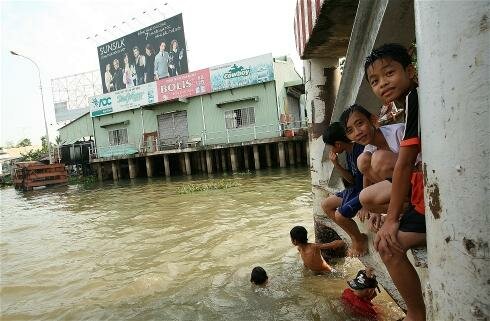Everything I Needed to Know About Survival, I Learned from a Computer Game
Games, and cartoons, boost youth disaster preparation.
NGOs and UN agencies warn that natural disasters disproportionately affect youths and that more creative use of media is needed to help brace them for natural calamities.
According to the UN Children’s Fund (UNICEF), at least half of those affected by natural disasters are youths under 18. Experiential learning (learning by doing), games and animated films are some ways entertainers and educators are using to teach youths disaster risk reduction (DRR) skills.
“Feeling and experiencing it [disaster simulation] empowers them. There are gains, especially in flood and cyclone areas of Asia where games have been helpful,” said Jordan Naidoo, a senior education adviser with UNICEF in New York.
The Asia-Pacific region has been hardest hit by natural disasters, with an estimated two million people killed from 1970-2011, or 75 percent of global deaths from natural disasters in that period.
Helping children handle stress before a disaster hits is critical, especially as countries confront slow-onset disasters in addition to rapid-onset ones, said Naidoo.
“While in Asia there tend to be more sudden onset emergencies such as earthquakes, volcanoes, typhoons (flood and wind hazards), in the Middle East the types of emergencies are slow and complex, such as conflict, war and drought. In [each of] these situations, we use games differently, to help children deal with their emotional stress.”
Games
Games are effective in helping children prepare for calamity, said Unni Krishnan, head of disaster response for international NGO Plan International.
The agency helped design a DRR board game, Riskland, in Viet Nam. Similar to “snakes and ladders” (known as “chutes and ladders” in some countries) the Vietnamese adaptation includes illustrations from schoolchildren that depict local geography to teach about climate change and local environmental threats, such as flooding and winds. Like the original game, the object is to navigate from start to finish, helped or hindered by ladders and snakes/chutes.
According to a recent Plan International and UN Office for Disaster Reduction (UNIDSR) report, games help children socialize and boost their confidence to discuss disasters with peers and family.
Cartoons
Thai and Indian youths have learned about flood preparation from a whale and elephant, respectively. A locally produced Thai animation broadcast during late 2011 flooding in Thailand called Roo Su Flood (Know, Fight Flood), attracted over 78,000 “likes” on YouTube the day it was uploaded, a number that has since grown to more than 650,000, according to the channel’s counter.
 Thailand-based Asia editor Jon Russell from the internet technology blog The Next Web, said he believed the cartoon’s popularity came from the perception its information was “unbiased and reliable”. Up to that point, Russell said government officials had provided conflicting flood assessments, announcing that the floods were under control one day, only to issue threatening warnings soon after.
Thailand-based Asia editor Jon Russell from the internet technology blog The Next Web, said he believed the cartoon’s popularity came from the perception its information was “unbiased and reliable”. Up to that point, Russell said government officials had provided conflicting flood assessments, announcing that the floods were under control one day, only to issue threatening warnings soon after.
Over six months, flooding in Thailand killed at least 628 people, affected more than 13 million, and damaged 20,000sqkm of farmland. Elsewhere in the region India’s government and the UN Development Programme turned to an elephant figure popular among children to teach the dangers of floodwaters through colouring books.
Slum art
In some slum districts of Dhaka - Bangladesh’s capital that is listed among the world’s most natural disaster-prone cities - even a relatively small amount of rain can cause flooding due to poor drainage systems and even poorer construction.
NGOs there have helped children create murals and community plays in some of those settlements outlining fire hazards and just how dangerous a clogged drain can be.
UNICEF and the Dutch government worked to strengthen national DRR education following the country’s Cyclone Aila in May 2009, which killed an estimated 190 people. The same area was hit two years earlier by another cyclone that killed 3,500.
To reach children not in schools, NGOs have used community plays in one of Dhaka’s slums, Jatrabari, to teach children living in overcrowded, fire-prone bamboo-and-tin homes about fire hazards.
No matter the media, children must be central to DRR learning, said Krishna from Plan International, who credits them with being excellent information and education “sponges”.
She said a 2010 tropical storm in El Salvador tested schoolchildren from El Zapotal, some 120km from the capital of San Salvador. “Children were in the forefront of evacuation and thus saved 415 people in their village from certain death of being buried alive by landslides.”
In consultations UNISDR held with more than 200 youths from six Asian countries in 2012, almost all those interviewed said they did not want to be viewed as victims, but rather as people protecting their communities.- IRIN

















